Learn more about Mechanics:
AbbreviationsCapitalizationCompound Words: Everything You Need to KnowContractionsSpellingToward vs. Towards: What's the Difference?

Toward and towards mean the same thing. They represent one of those rare times when there isn’t a complicated rule to follow. Toward and towards are similar to color and colour. The differences don’t go any deeper than the physical appearance of a letter, with the no s version representing an American spelling and the added s version representing a British spelling.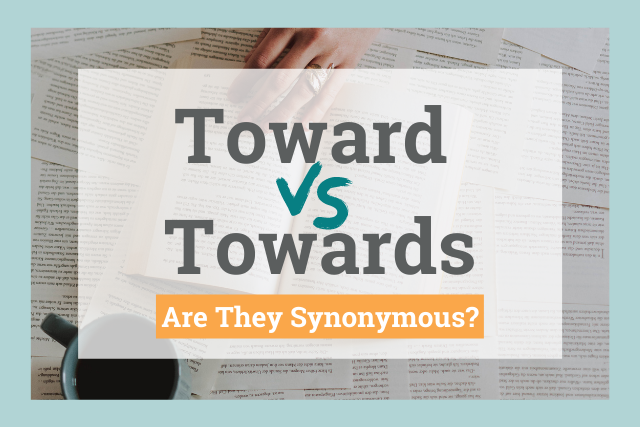
If I take a step in your direction, am I moving toward you or am I moving towards you?
Want to fight about it? Grammarians in past centuries certainly did. (Well, maybe they just argued.)
In 1867, grammarian Edward S. Gould published his book Good English, which included an article dedicated to the use of toward or towards. He was not happy about the inclusion of that end-of-the-word s in towards or in other words like it, calling such usage “arbitrary,” “capricious,” and “ignorant.”

Want to know who won the battle of toward vs. towards? I’ll tell you, but first, you have to sing along!
You like potato and I like potahto
You like tomato and I like tomahto
Potato, potahto, Tomato, tomahto.
Let’s call the whole thing off
Can you see what answer we are heading toward(s)?
Should You Use Toward or Towards?
Thankfully, by the end of their song, Ella Fitzgerald and Louis Armstrong realized their preferred word pronunciations were not reason to “call the whole thing off” and just represented unimportant personal preferences.
When it comes to toward vs. towards, we can follow Ella and Louis’s lead. No need to fight.
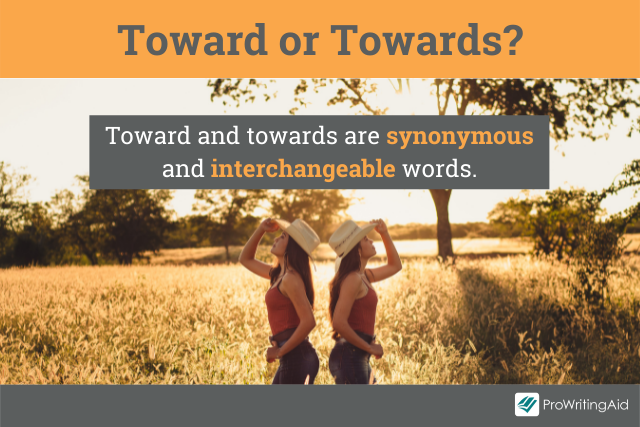
Toward and towards represent one of those rare times when there isn’t a complicated rule to follow. Toward and towards are similar to color and colour. The differences don’t go any deeper than the physical appearance of a letter, with the no s version representing an American spelling and the added s version representing a British spelling.
Including the “s” does not change the meaning or make the word plural (since it’s not a noun, that rule wouldn’t apply anyway). The bottom line about the use of toward(s) is pretty simple, actually.
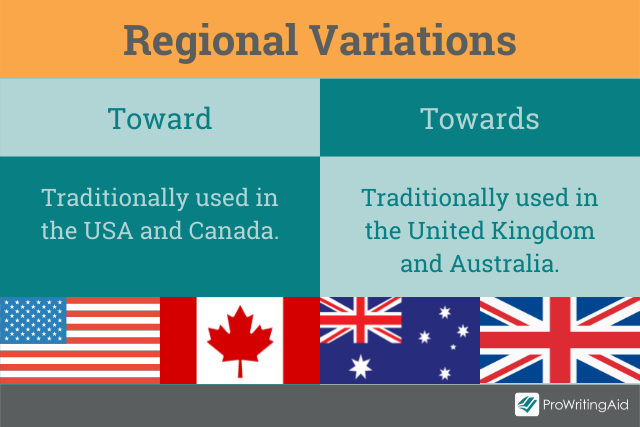
- Common use among English speakers in the USA and Canada is toward
- Common use among English speakers in the UK and Australia is towards
Those tendencies aren’t hard and fast rules or meticulously followed preferences even. You might come across a “towards” in North American writing. And though less likely, you could find a “toward” in British writing.
Toward vs. Towards in the Style Guides
Though preference is the general guideline for using toward(s), if you’re writing for a particular publication, you should check the style guide followed by whatever publication it is you’re writing for.
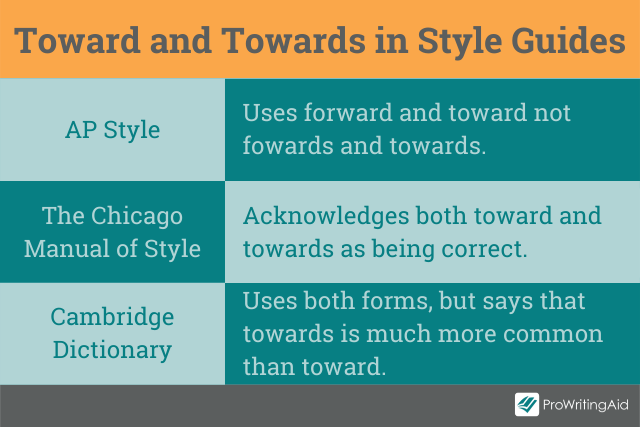
@APStylebook tweeted this a few years ago: “AP Style tip: We use forward and toward, not forwards and towards.”
The Chicago Manual of Style acknowledges both spellings of the word, but as an American press, prefers toward.
On the other hand, the Cambridge Dictionary includes this statement:
We can use both forms, but towards is much more common than toward.
How to Use Toward vs. Towards
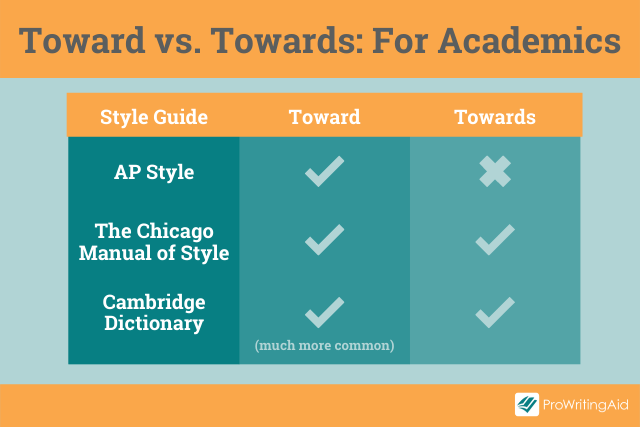
Both toward and towards are legitimate words and other than the missing or added s (whatever your perspective), they mean the same thing. So what is that meaning?
Toward(s) is a preposition meaning “in the direction of” and “as regards or in relation to” according to Google Dictionary/Oxford Languages. Those definitions are helpful, but seeing the word in various contexts reveals more of the nuances in how the word can be used.
“In the Direction of”
The direction indicated by toward(s) can be literal and physical or figurative.
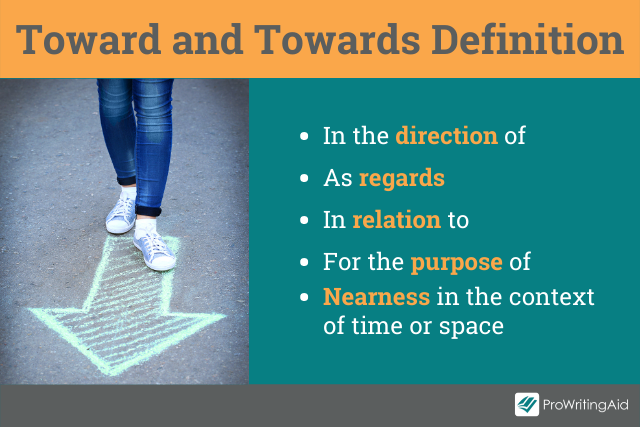
Literal Direction
- We are walking towards the shoreline.
- Drive toward the school.
- The baby crawled towards the toy.
- Sunflowers turn their faces toward the sun.
Figurative Direction
- He’s shifting his eating habits toward a healthier diet.
- I’m moving toward my Master’s Degree.
- The financial system is moving toward collapse.
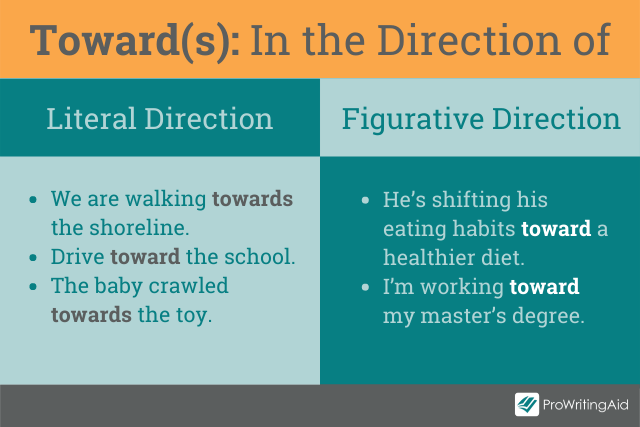
“As Regards / In Relation to…”
- I have feelings of animosity towards her.
- The neighbors were friendly towards each other.
- Energy consumption trends are moving toward efficiency.
“For the Purpose of”
- I am saving toward a new car.
- Each test grade counts toward your final average.
- My friend donates money toward a different worthy cause every month.
Nearness / Closeness
- The bedroom is toward the back of the house.
- The sunset is setting earlier as we head towards winter.
- The young students get tired and cranky towards the end of the school day.
Words Like Toward(s)
Toward(s) is one of several directional words. Others include forward, backwards, upward, downwards, inward, and afterwards.
Did you notice both the presence and absence of the “s” at the ends of the words?
As with toward and towards, these directional words exist under the same rule of “go with your preference.” The words’ meanings are interchangeable and use is largely based on where you live or what style guide you’re following.
Toward as an Adjective
Merriam-Webster defines toward in these ways when the word is used as an adjective:
Coming soon; imminent, e.g. The storm is toward!
Happening at the moment, e.g. The celebration is toward.
Propitious or favoring, e.g. The toward wind helped us sail safely home.
You probably have not seen toward used as an adjective anytime recently. Collins dictionary notes that its use is “rare.” This usage has fallen out of practice and you’re much more likely to encounter it in literature from centuries past than in current publications.
What Does Untoward Mean?
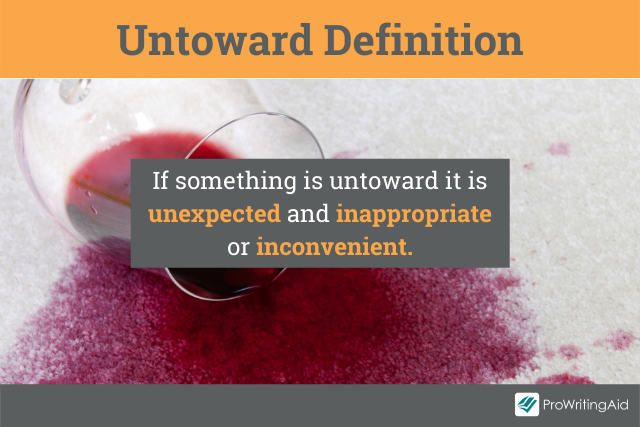
Interestingly, untoward is an adjective with more frequent modern-day use. Something untoward is inappropriate, improper, or unfortunate.
There was something untoward about their appearance at the party.
His untoward behavior requires discipline.
Untoward circumstances forced them into financial straits.
Note: The adjectives toward and untoward do not include the final s.
Common Phrases and Idioms Using Toward(s)

Count toward: Work from home hours count toward your earnings.
Go a long way towards: Your apology will go a long way toward healing the relationship.
Gear towards: The presentation is geared towards adolescents.
Harbor toward: I harbor no ill-will toward her.
Move toward: Let’s move toward the front of the room.
Lean or leaning toward: I’m leaning toward getting the red one.
Point towards: Early indicators point toward success!
Push toward: They are making a push toward energy efficiency.
Trend/Trending towards: Data indicates viewers are trending toward streaming services for entertainment.
Turn toward: Turn toward the audience when you speak.
Veer toward: The van started to veer toward the pedestrians.
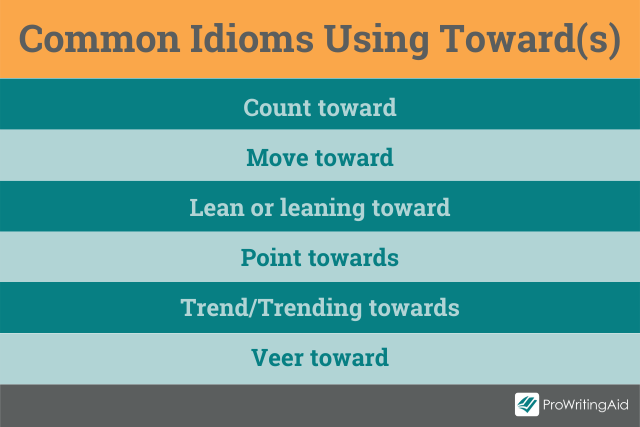
What to Remember When Using Toward or Towards
It’s rare for a word to have such an easy non-rule of use. How often can you be right now matter what answer you choose? When it comes to the English language, the answer is “not very.” So the acceptance of toward and towards is a refreshing relief from that complexity. There may be other words that don't have such easy rules. That's where ProWritingAid Grammar Report comes in. It will catch all those silly but easy to make mistakes.
Try the grammar report with a free ProWritingAid account.
However, Edward S. Gould is certainly not the last grammarian to criticize grammatical preferences and styles, so keep these guidelines in mind when you find yourself writing toward/towards.
Toward is generally the preferred use in the United States and Canada.
Towards is generally the preferred use for the United Kingdom and Australia.
If you’re writing for a specific publication, make sure you know what style guide they follow, and then do what the guide recommends or requires.










